Looking to optimize your business processes? Our ServiceNow development services bring seamless integration and automation, improving service delivery and operational efficiency across IT, HR, and customer service.

They go above and beyond to ensure quality and satisfaction. A true partner in every sense.
- Rebecca
More than 75% of organizations face process inefficiencies. ValueCoders helps you break through by building effective, automated workflows using ServiceNow that streamline your business operations and improve collaboration across teams.
Transform business requirements into tailored ServiceNow applications that address specific operational challenges.
Eliminate repetitive manual tasks with intelligent process flows designed for your unique business requirements.
Deliver engaging, intuitive interfaces that enhance user experience for both employees and customers.
Maintain comprehensive visibility and control over your IT infrastructure components and relationships.
Organize service offerings into user-friendly catalogs that streamline request fulfillment across the organization.
Translate complex data into visual insights that drive strategic decision-making and performance improvements.
Bridge your ServiceNow platform with existing business systems to create unified digital workflows.
Seamlessly transition to the latest ServiceNow releases while preserving customizations and business continuity.
We set up logic-driven ServiceNow processes that reduce approval delays and help internal teams move faster.

Our certified ServiceNow developers utilize deep platform knowledge, specializing in ITSM, ITOM, and custom app development.
We follow platform best practices, ensuring scalable, secure solutions tailored precisely to your automated workflow requirements. Thus, we deliver maximum platform value from day one for your business needs.
We build ServiceNow workflows that reduce manual work by 60% and keep departments synced across ticketing, requests, and assets.
Partnering with businesses in diverse sectors to unlock new avenues for growth and innovation.
We combine ServiceNow’s native capabilities with modern technologies to build scalable, secure, and performance-driven enterprise solutions. Here’s a breakdown of the core tech stack we use across various layers of development:
At PixelCrayons, our ServiceNow development process is built on agility, transparency, and technical precision. We craft secure and scalable enterprise solutions using iterative development practices that keep projects aligned with business goals.
We initiate with bi-weekly sprints and planned rollouts tied to project goals.
Cross-functional teams execute tasks, completing user stories within sprint cycles.
Scrum-led check-ins ensure blockers are addressed and progress stays aligned.
QA engineers test all new features for function, stability, and integration.
Sprint backlogs are routinely updated to reflect ongoing progress and changes.
After each sprint, we evaluate results and adjust to improve upcoming cycles.
Choose from our flexible hiring models designed to fit your needs and budget.
For businesses with well-defined project scope and requirements.

For businesses with long-term project requirements or complex development process. They get more control of the process.

For businesses looking to pay for completed project instead of committing to fixed project cost.

Follow this simple guide to plan, build, and manage ServiceNow applications with a clear focus on business goals and real-time efficiency.
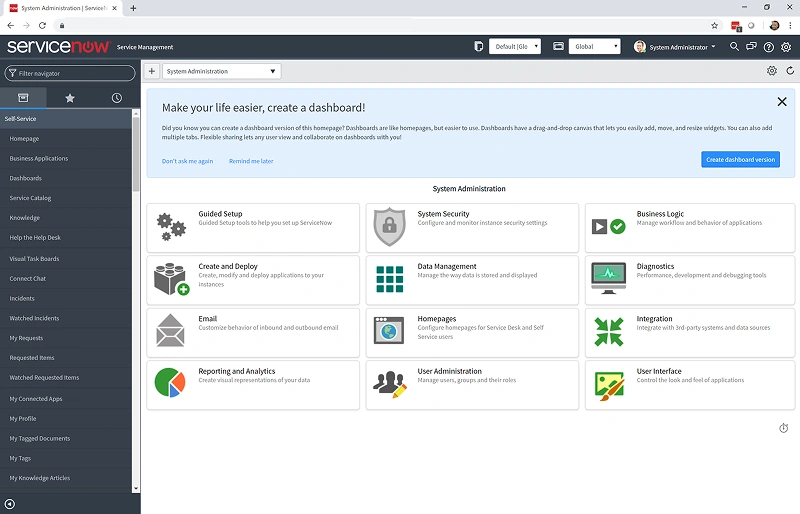
The ServiceNow platform is used by businesses to manage IT, employees, and operations in one place. It helps teams work faster by bringing services, data, and workflows into a single system. This makes it easier to track and handle tasks.
Key Components of the Platform
ServiceNow has many core parts that support different business needs. These parts work together smoothly to help you manage your work better.
Here are some main components you should know:
Why These Matter
Each part of the platform plays a clear role. Together, they help businesses:
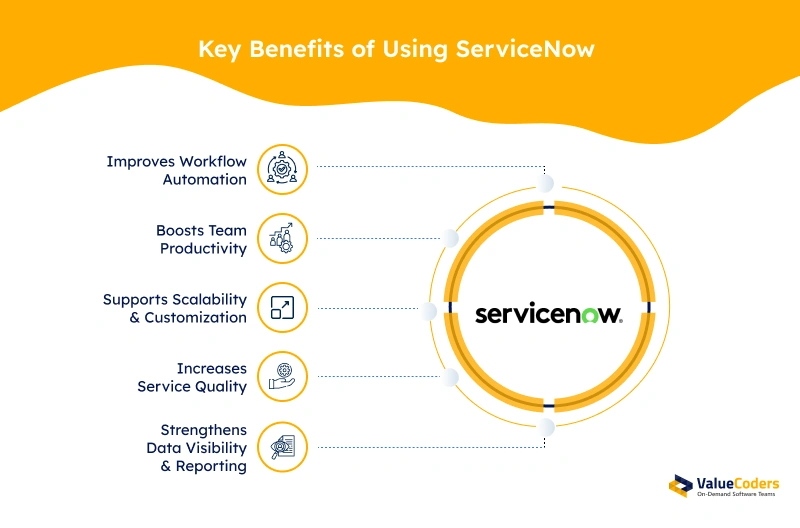
ServiceNow helps you organize your business operations in one place. If you manage tasks across many teams, ServiceNow makes it easier and faster. It also reduces errors, saves time, and gives your team more control over daily tasks.
1. Improves Workflow Automation
ServiceNow automates many of your daily business tasks, eliminating manual steps. It also connects departments and systems, so your team doesn’t waste time switching tools.
Here’s how automation with ServiceNow helps:
2. Boosts Team Productivity
ServiceNow keeps everything organized. When your team has clear tasks and data, they get more done. You also avoid back-and-forth communication and delays.
Benefits for your teams include:
3. Supports Scalability & Customization
Your business may grow or change. ServiceNow grows with you. You can add new features or create your own apps when you need them, keeping your system useful.
With flexible scaling, you get:
4. Increases Service Quality
Customers and employees get quick and helpful answers. ServiceNow tracks service levels and finds problems early.
This leads to:
5. Strengthens Data Visibility & Reporting
ServiceNow gives you real-time data so you can make faster and smarter decisions. You don’t have to guess what’s working or where issues are.
With better reporting tools, you get:
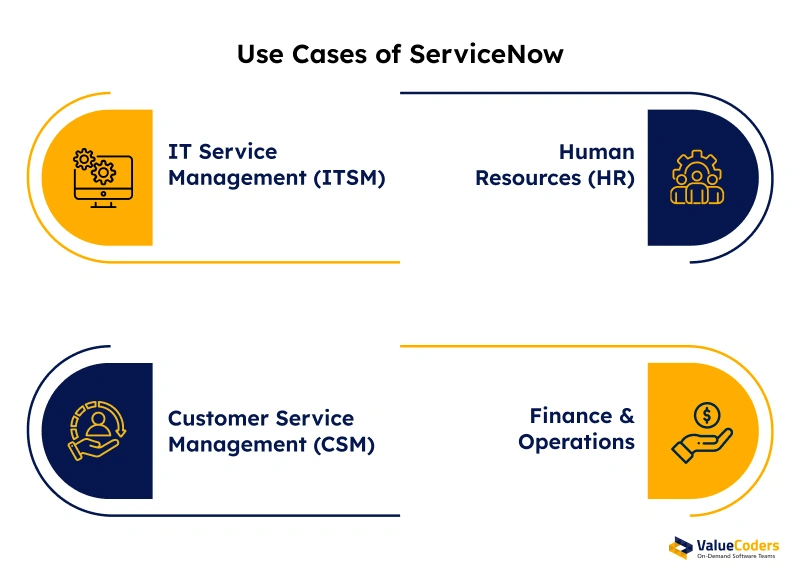
ServiceNow is not just for IT teams. It helps different departments in a company work better and faster. With proper ServiceNow software development, businesses can improve how they manage tasks, people, and services.
Here’s how different areas in a business use ServiceNow effectively.
1. IT Service Management (ITSM)
IT teams use ServiceNow to solve employee tech problems quickly. It cuts down wait times and helps track issues better.
Key benefits for IT:
With smart ServiceNow software development, IT teams can connect tools, set rules, and reduce manual work.
HR teams manage many requests from employees. ServiceNow helps them stay organized and respond faster.
HR teams use it to:
It reduces emails and improves employee experience.
3. Customer Service Management (CSM)
ServiceNow lets businesses support their customers without delays. With the right development, it connects data from different tools and helps resolve complaints faster.
Benefits for customer service:
ServiceNow also supports backend functions like finance. It helps teams manage approvals, vendor interactions, and payments.
How finance teams use it:
With tailored ServiceNow software development, finance teams save time and reduce mistakes.
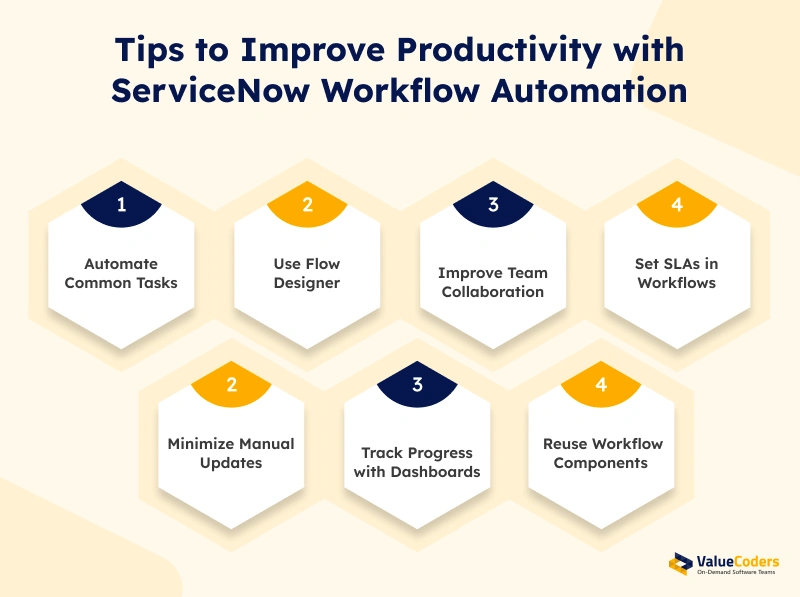
ServiceNow workflow automation helps your teams do more in less time. When used the right way, it reduces manual work and improves accuracy. If you’re planning to use ServiceNow software development for your business, here are seven ways to boost your team’s productivity with it.
1. Automate Common Tasks
Many tasks in IT, HR, and customer service repeat every day. With ServiceNow, you can build flows to handle them without human input.
Here are some areas where this works well:
2. Use Flow Designer
Flow Designer is a low-code tool in ServiceNow. It helps you create workflows fast, even if you’re not a developer.
Why it helps:
3. Improve Team Collaboration
ServiceNow workflows help different teams talk to each other better. For example, IT and HR can share workflows for onboarding or access management.
This removes delays caused by miscommunication.
4. Set SLAs in Workflows
Add SLAs (Service Level Agreements) inside workflows. This keeps everyone on track and ensures no work is delayed.
It also helps you monitor performance in real time.
5. Minimize Manual Updates
ServiceNow software development allows smart updates. You can create logic to auto-update records based on changes.
That means:
6. Track Progress with Dashboards
Every workflow can connect to dashboards. These give a clear view of tasks, pending work, and bottlenecks.
You can quickly act on what’s slowing you down.
7. Reuse Workflow Components
Instead of building flows from scratch, reuse existing ones. ServiceNow supports modular design to save effort across projects.
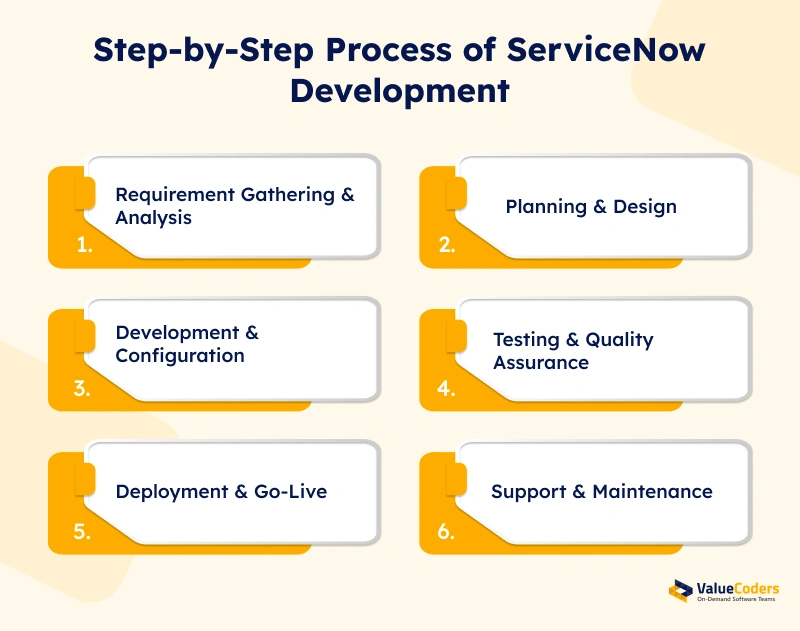
Developing applications on the ServiceNow platform follows a structured approach. This helps ensure that the final product meets the business’s needs. Each step is important and builds on the one before it. Understanding this process can help businesses know what to expect when building on ServiceNow.
1. Requirement Gathering & Analysis
The first step is to determine exactly what the business needs the application to do. This involves talking to the people who will use the application.
Technical details like data fields, workflows, and integrations with other systems are also noted during this stage. This makes sure everyone has a clear picture of what needs to be built.
2. Planning & Design
Once the requirements are clear, the next step is to plan how the application will work. This includes designing the user interface (how it looks) and the user experience (how it feels to use).
Technical architects often create diagrams and specifications during this phase. They also decide how best to use ServiceNow features like GlideRecord for data access and Client Scripts for user interactions.
3. Development & Configuration
This is where the application is actually built on the ServiceNow platform. Developers use ServiceNow tools and scripting languages like JavaScript to create the forms, workflows, and integrations.
Developers write code and configure the platform based on the design documents. They use ServiceNow Service Portal for user-facing interfaces and ServiceNow Studio as the Integrated Development Environment (IDE).
4. Testing & Quality Assurance
After the application is built, it needs to be tested to make sure it works correctly and meets the requirements. Different types of testing are done.
Testers look for bugs and ensure the application is stable and performs well. They might automate some of the testing using the ServiceNow Automated Test Framework (ATF).
5. Deployment & Go-Live
Once the testing is successful, the application is moved to the live ServiceNow environment, where users can access it.
Careful planning and execution are needed for a smooth deployment. This step makes the application available to the business users.
After the application is live, ongoing support and maintenance are important. This includes fixing any issues and making updates or changes as needed.
The ServiceNow platform receives regular updates, so maintenance also involves ensuring the custom applications work well with these updates. This ensures the application remains valid over time.

Choosing the right partner for ServiceNow development services is not just about cost. You need someone who truly understands your business needs and has strong technical skills. The wrong partner can delay your project or waste resources. So here’s a simple checklist to help you pick the right one.
1. Experience with Similar Projects
Check if the partner has handled projects in your industry. They should know how to build a ServiceNow solution that matches your goals.
Look for these signs:
2. Certified & Skilled Team
You need developers who are trained and certified. This ensures they know the platform well and follow best practices.
Ask about:
3. End-to-End Development Services
Choose a partner who can handle full-cycle ServiceNow software development. This includes planning, coding, testing, deployment, and support.
Make sure they offer:
4. Strong Communication & Support
Good communication saves time and avoids confusion. The partner should give regular updates and quick support.
What to look for:
5. Focus on Business Outcomes
Your partner should not just follow instructions. They should help improve your process through smart ServiceNow solutions.
They should help with:
Choosing the right ServiceNow development company takes time. But with the right checklist, you’ll avoid risk and build strong, useful systems that actually help your business.
Curious about how ServiceNow can transform your business? We’ve compiled answers to your top questions, giving clear insights into our tailored ServiceNow development solutions.
Ans. ServiceNow application development supports ITSM apps, HR portals, customer service platforms, asset tracking tools, and custom workflow solutions. Our ServiceNow development services help businesses build apps tailored to specific internal operations and process automation needs.
Ans. Yes, ServiceNow development allows easy integration with tools like Jira, Salesforce, Microsoft Teams, Slack, and more.
We support:
Ans. Yes, every ServiceNow solution we build includes long-term support. As a ServiceNow development company, we handle upgrades, patch fixes, performance tuning, and functional improvements to keep your ServiceNow software development stable and secure post-deployment.
Ans. Yes. Data migration is handled by our ServiceNow development team using structured steps:
We ensure zero data loss and high accuracy.
Ans. ServiceNow development services are priced based on complexity, modules required, and customization level. Cost depends on:
Ans. Using our ServiceNow development services, businesses get real-time dashboards, performance analytics, SLA tracking, audit trails, and customized visual reports. These features simplify monitoring and decision-making and help measure KPIs across multiple departments effectively.
Ans. Every ServiceNow solution starts with a clear discovery phase. We align technical features with business needs. Our ServiceNow development services include regular check-ins, custom KPIs, and testing for real-use scenarios.
We are grateful for our clients’ trust in us, and we take great pride in delivering quality solutions that exceed their expectations. Here is what some of them have to say about us:

Co-founder, Miracle Choice

Executive Director

Director

Director
Trusted by Startups and Fortune 500 companies
We can handle projects of all complexities.
Startups to Fortune 500, we have worked with all.
Top 1% industry talent to ensure your digital success.



Let's discuss how we can bring your vision to life.